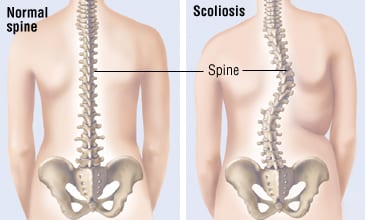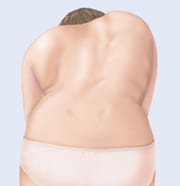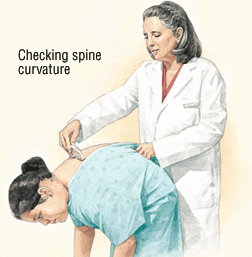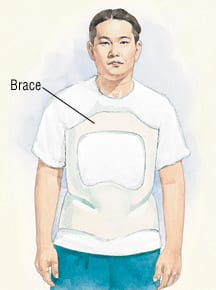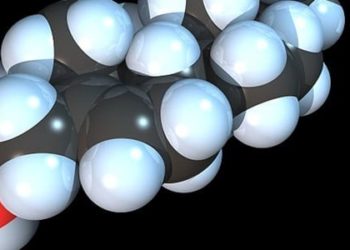Patient Basics: Scoliosis
Originally published by Harvard Health.
What Is It?
A normal spine has several front-to-back curves between the neck and the pelvis. In scoliosis, the spine curves abnormally to the side or twists. Although scoliosis seems to run in some families, most cases appear for unknown reasons in children and adolescents who previously had a straight spine. Scoliosis without a known cause is called idiopathic scoliosis. Girls and boys are affected equally by idiopathic scoliosis, but girls with this condition are more likely to develop curves that get big enough to require treatment.
In a few cases, the cause of scoliosis is known. These include:
- Congenital scoliosis – This happens when the spine fails to form completely or forms improperly during development (while in the womb).
- Neuromuscular scoliosis – This can happen when the spine’s discs and bones break or deteriorate in adulthood. It also can happen because certain diseases, such as cerebral palsy, cause the muscles to support the spine unevenly or to pull at the spine unevenly.
- Osteoporosis with fractures — The bones are prone to fracture in people with osteoporosis and the spine is a favored location for fracture. If one side of a vertebra (spine bone) compresses more than the other side after it fractures, the spine may curve as a result.
Scoliosis is a long-term (chronic) disease that can worsen over time. Sometimes a curved spine that develops during infancy or early childhood may go unnoticed and untreated until the teenage years. The abnormal position of the spine can affect the development of muscles and ligaments associated with the spinal column, causing the ribs and pelvis also to twist and rotate to the side.
Symptoms
Normally, when you look at a person’s spine from the front or back, it appears straight. When a person has scoliosis, the spine typically curves out to one side and then back again, or, more commonly, has two bowed-out areas that balance each other, resembling an S shape. Other signs can include:
- One shoulder that appears lower than the other
- A rounded shoulder
- A sunken or asymmetrical (uneven) chest shape
- A spine that curves inward or downward too much, known as a sway back
- A pelvis that thrusts forward on one side
- One leg that appears shorter than the other
Most people with scoliosis are not bothered by it other than abnormal posture and cosmetic concerns. If scoliosis is severe and untreated, it can cause additional problems, including:
- Back pain that may appear in adulthood as ligaments weaken
- Tingling or numbness in the legs
- Permanent deformities
- Fatigue (tiredness)
- Breathing problems
- Heart problems – Rarely, scoliosis is associated with abnormal heart mechanics, such as a heart valve abnormality known as mitral valve prolapse. It is not clear whether the abnormal shape of the upper body leads to this problem, or if the valve and spine both developed abnormally because of a single growth problem.
Diagnosis
Starting at age 8 or 10, most children and adolescents are checked for scoliosis at each routine physical examination. Many states require public schools to screen students for scoliosis, usually in the fifth or sixth grade. During the exam, the health professional will ask the child to stand up straight, then bend over and try to touch his or her toes. This bent-over position allows the examiner to check for curvature in the spine, for an abnormal body tilt to the left or right, or for one shoulder blade that is raised higher than the other. The overall value of routine screening is not clear.
If your child’s school nurse or your family doctor suspects scoliosis, he or she may refer you to a spine specialist, usually an orthopedic surgeon (a specialist who treats diseases of the bones and joints), for further examination. To help with the diagnosis, a series of spinal X-rays often will be taken. Using these X-rays, the specialist will determine the severity of the scoliosis and the risk that it will worsen. Once this is done, the doctor will recommend specific treatment.
Expected Duration
Scoliosis is a lifelong condition that usually begins in childhood or adolescence. Once rapid bone growth ends after puberty, scoliosis usually does not worsen. As the spine undergoes normal weakening in adulthood, curvatures and symptoms can worsen gradually.
Prevention
Except for osteoporosis-related scoliosis, most cases of scoliosis cannot be prevented. There is no evidence to suggest that improving posture or doing exercises can prevent it. Measures to increase bone mass and strengthen bones, including getting enough calcium and vitamin D, and doing regular weight-bearing exercise, may help to prevent cases caused by spinal fractures. In some cases, early detection may prevent the condition from getting worse.
You should examine your child’s spine regularly, starting in infancy, and talk to a health care professional about any concerns. School nurse evaluations and regular pediatric examinations also can identify cases of scoliosis.
Treatment
The treatment of scoliosis depends on the patient’s age and sex, the severity of spinal curvature, the location of the curve, the type of scoliosis, and in girls, whether the patient has started to menstruate. The age at which menstruation begins is an indicator of the stage of bone growth, which helps determine the risk that the disease will progress.
Most cases of scoliosis are mild and require no treatment. However, to make sure that the curve does not get worse, the person should be examined regularly by a doctor. More severe cases that cause discomfort or other symptoms and mild cases that are likely to get worse often require treatment, which may include back-strengthening exercises. For the worst cases of scoliosis, special back braces and even surgery may be recommended.
When To Call a Professional
Contact your child’s doctor for a thorough exam if you notice that your child has any signs of scoliosis or if an abnormal curve in the spine was detected during a school screening program.
Prognosis
When scoliosis is detected early, treatment usually can prevent the problem from getting worse. Most cases of scoliosis are mild and cause no discomfort or physical limitations. In extreme cases that require surgery, the patient usually recovers quickly. Although most people with mild scoliosis can continue normal activities, some people are advised to avoid heavy contact sports or gymnastics. Your doctor will discuss any specific activity limitations with you. Without treatment, severe scoliosis can cause significant deformity and some pain or breathing problems in adult years.
Additional Info
National Scoliosis Foundation
5 Cabot Place
Stoughton, MA 02072
Toll-Free 1-800-673-6922
Fax: 781-341-8333
http://www.scoliosis.org/

